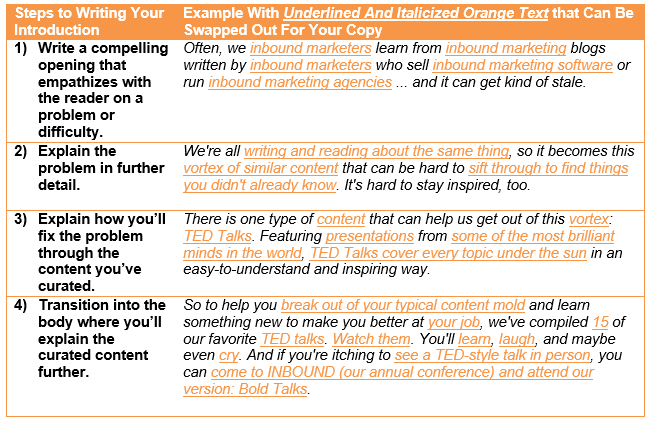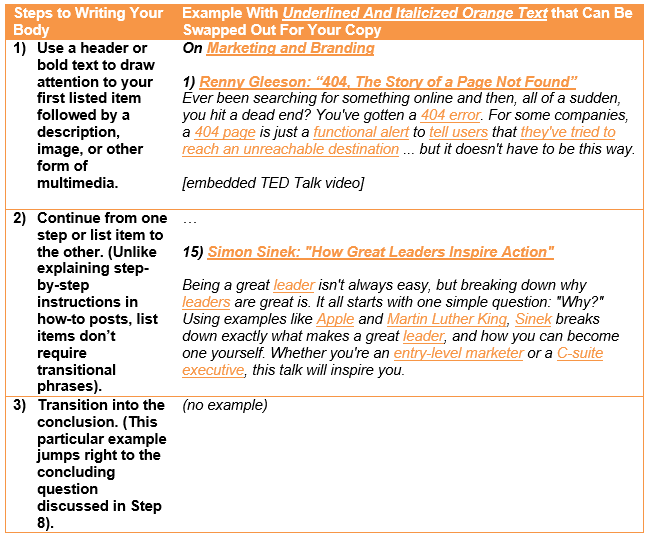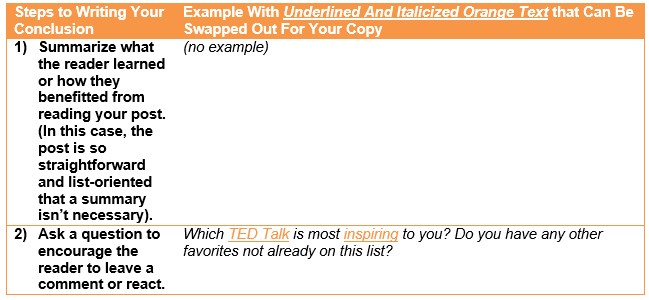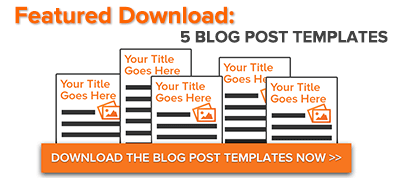 I’m going to let you in on a little secret: Not all of the content you create has to be 100% original.
I’m going to let you in on a little secret: Not all of the content you create has to be 100% original.
I know. Mind-blowing, right? And for those of you inbound marketers plagued by the incessant demands of content creation, maybe also a little comforting?
Now before some of you get all “But content curation is lazy!” and “Content curation is why there is so much crap on the internet,” hear me out.
Sure, curated content is a collection of other people’s content and resources from around the web. But that doesn’t mean it can’t be valuable. Just think about a collection of mint condition vintage toys. Each toy that comprises the collection is valuable in and of itself — but a collection of many is even more valuable. See what I’m getting at?
The point is, if all you’re doing is quickly throwing together a few pieces of subpar content, then yes, content curation can absolutely be lazy and crappy. But take the time to curate a lot of valuable pieces of content, and you’ll end up with a collection that’s valuable to both the content consumer and yourself. Because not only does curation save you the step of creating content from scratch, but it also gives the viewer all that awesome content in one place. And here’s another thing: Curated content also has a lot of potential to rank well in search. Talk about a win-win-win!
We’re going to walk you through how to compile a valuable curated blog post in this post. But first, download the free curated blog post template — plus four other helpful blog post templates — right here so you can follow along and easily create curated posts for your own blog. And don’t forget to check out our additional tips for creating curated blog content at the bottom of this post!
Got your template? Great! Let’s get started …
Plan Your Curated Collection Blog Post
First, take several minutes to plan what you want to write about so that you can stay on topic and keep your readers engaged.
Step 1: Identify Your Audience
Which buyer persona are you writing this blog post for? Complete this field in your template.
Step 2: Identify Your Key Takeaway
What do you want your audience to learn after reading your curated blog post? Put your thoughts into your template.
Step 3: Identify Which Types of Content You Want to Curate
What content matters to your audience that you don’t have the time or resources to create? Take a look at these ideas for valuable curated content, then jot down the content types or resources you plan to compile for your post in your template. Are they videos? Slideshows? Charts and graphs? Links to articles or ebooks?
Step 4: Brainstorm a Few Possible Titles
You don’t have to pick the perfect title before your blog post is done, but it definitely helps to jot down a few ideas to help keep you focused during the writing process.
At HubSpot, we call this a working title — a title that you can “work” off of that guides your post and helps you resist the urge to ramble off into a million different directions. Once the post is complete, we usually fine-tune it to ensure the title accurately reflects the post content, grabs potential readers’ attention, and is optimized for search.
For example, before finalizing the title for a blog post to support the downloadable presentation we put together for Halloween 2013, we brainstormed several titles before choosing a working title, and then revised that title further to come up with the final title:
- 13 Stats to Spook Your Boss Away From Traditional Advertising
- 13 Stats That Will Spook Your Boss into Adopting Inbound Marketing
- 13 Spooky Stats to Scare Your Boss Away From Ineffective Marketing Tactics (working title)
- 13 Spooky Stats to Scare Your Boss Into Better Marketing (published title)
Use the space in your template to craft a few possible blog post titles, and then choose one as your working title. Don’t worry about finalizing your title until you’re finished writing and curating.
Step 5: Create an Outline
The typical curated content post consists of:
- An introduction: sets the stage for what you plan to address through your collection of curated content
- A body: expands on every bullet, list item, step, and example in a logical order
- A conclusion: wraps up your post with a brief statement that’s reflective of what your readers just learned
What are all the bullet points you need to cover to introduce your compilation, explain each point, and remind the reader what they just learned? Use these questions to help you create an outline in your template.
Create Your Curated Blog Post
Step 6: Write the Introduction
When writing your introduction, you want to keep one question top of mind: How can I establish credibility and get my audience to care about the resources I plan to share with them?
Feel free to leave the introduction for last, too. Sometimes it’s easier to introduce your post after you’ve written the real meat of it. When you do write your intro, here’s how we recommend going about it, using the blog post, “15 Phenomenal TED Talks You Need to Watch Today” as an example:

Note: The template content we’ve provided here is not intended to be copied and pasted into every blog post you write. That results in duplicate content for which you’ll be seriously punished in the SERPs. These templates simply help you start putting pen to paper — or cursor to screen — and help you think through the structure and process of a curated blog post to make the whole writing experience far less painful. We highly, highly encourage you to incorporate your own original copy.
Now it’s your turn! Start crafting an introduction in the field provided in your template.
Step 7: Write the Body
Remember: The body should follow through with what you promised in the introduction. Your body can be written in paragraphs, with bullets, numbered lists, multiple headings, or a mix of any of these. Feel free to make use of whichever format is easiest for you given the types of content you’re curating.
Just be cognizant of these questions: How many examples do I need to include to make this post valuable to readers? How in-depth do I need to go into each example to make them easier to understand? Can I add any visuals that will make my post any easier for my readers to understand and consume?

Ready to start crafting your post’s body? Fill in the box provided on your template.
Step 8: Write the Conclusion
Your conclusion is where you’ll paraphrase the key takeaway you outlined earlier in the planning stages and/or prompt your reader with a question.

What’s your conclusion? Write it in the text box on your template.
Step 9: Link to Additional Resources Within Your Post
Sometimes it’s hard to say everything you want to say about a single topic in one post, which is why it’s helpful to your readers to identify additional resources you can link to for more detail or credibility.
Hyperlinking to other blog posts or pages on your site can result in increased visibility in search engines, page views, and time on site. In addition to links to the third-party content you’re curating, think about what other resources you can reference to strengthen the points made in your post, and then place those links in the field on your template.
When you insert your blog post copy into your blogging platform, create hyperlinks for these resources where they fit best.
Step 10: Finalize Your Title
Revisit your working title and see if you can make it more accurate, specific, sexy, concise, and SEO-optimized.
Need help? Check out this post on writing kick-ass titles. Then, put your finalized title in the field on your template.
Step 11: Choose a Call-to-Action (CTA)
At the end of your post, what action do you want your readers to take? Do you want them to sign up for your newsletter? Request more information? Tweet something? Download something? Buy something? Ideally, the action is relevant to the content they just read. For help choosing the perfect CTA for every blog post, read this post. Once you’ve figured out what you want people to do after they read your post, you should add that into your template.
Prep Your Blog Post for Publishing
Step 12: Copy and Paste Your Blog Post Into Your Blogging Platform
Now that you’ve gone through the exercise of outlining and writing your blog post, you’ll want to prepare it for publishing.
A simple way to do this is to select and copy your finalized title and all your blog post body copy, and paste it into Microsoft Notepad (or TextEdit on a Mac). Pasting into one of these programs strips your copy of all formatting so that when you copy and paste it from the text editor into your blogging platform of choice, the formatting you apply within your blogging platform should render correctly. That being said, after pasting this into your platform, you should triple check that your formatting carried over.
Now’s the time to make your blog post more scannable by using headers, bold text for key points, hyperlinks, and images/embedded content like videos and slideshows where applicable. Also, if your CTA is a button, don’t forget to add that into your post, too.
Step 13: Edit, Edit, Edit!
Everyone can use a second set of eyes to look over their post before putting it out into the world, so have a friend or colleague look it over. Another thing that will help? This ultimate editing checklist.
Step 14: Select an Image
Every blog post should have an image. At HubSpot, we include at least one photo or image in every post we publish so that A) the content is more visual, and B) when the blog post is shared via social media channels, it’s accompanied by a thumbnail image to entice a clickthrough.
Take a look at our three free bundles of downloadable stock photos (general, business, and holiday) to see if any of these royalty-free images will do the trick for you, and if you want help deciding which photo to use, check out this quick post about selecting the perfect image for your next blog post.
Step 15: Optimize Your Post for Search
If you’ve spent all this time collecting and annotating your curated content, you’ll want to make sure your post is easily discoverable in search engines. Check out our post, “Blog SEO for the Modern Marketer: How to Optimize Your Posts” for tips on how to do just that.
Step 16: And Finally, Hit Publish!
Publish your post, and start tracking its performance!
Additional Tips and Recommendations for Curated Content
Keep It High-Quality and Relevant
No matter what type of content you’re curating, quality and relevance should always apply. No one wants to access a list of 10 mediocre industry blogs. They want the best. The individual content elements you curate, therefore, should represent the utmost level of quality — and you should explain what criteria you’re using to judge that quality. Remember: Quality is what separates valuable content curation from crappy content curation.
Furthermore, make sure the content you’re curating is relevant to your audience. That aggregated list of funny viral videos may very well be funny, but if you’re not in the business of humor or marketing, it might not belong on your blog.
Add Value
Although not a blog post, one of our top-performing ebooks, “101 Awesome Marketing Quotes,” is nothing more than a compilation of various inspirational quotations from marketing experts presented in a visually stimulating way. What made it so successful is that we did the homework to collect all 101 of those quotes, and then we presented them in a way our readers would enjoy.
Oftentimes, it isn’t enough just to aggregate. A blog post listing these 101 quotes probably wouldn’t have performed as well. By adding value (in this example, by adding visual elements), you essentially create something brand new and valuable out of content that already exists. Here’s a blog post that does this well.
Give Credit Where Credit’s Due
Since curation involves borrowing content that was created by someone else, you absolutely must attribute and link to the original source. Here’s a blog post that does this well, and here’s a guide to proper attribution in blog content.
Ready to start curating? Grab your five free blog post templates right here.
Have you tried content curation? Share some great examples of content curation in the comments.
![]()








